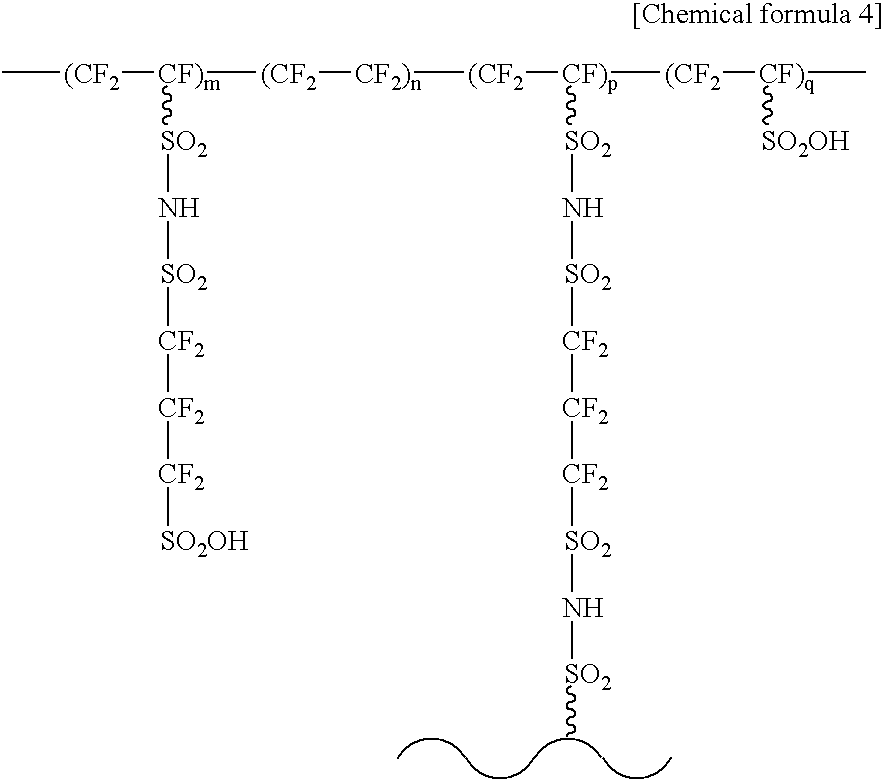Process for producing a modified electrolyte and the modified electrolyte
a technology of electrolyte and process, which is applied in the field of process for producing a modified electrolyte and a modified electrolyte, can solve the problems of low heat resistance of perfluoro polymer electrolyte typically represented by nafion, low efficiency of fuel cell,
- Summary
- Abstract
- Description
- Claims
- Application Information
AI Technical Summary
Benefits of technology
Problems solved by technology
Method used
Image
Examples
first embodiment
[0044] Preferred embodiments according to the present invention are to be described in details. The process for producing a modified electrolyte according to the present invention comprises an amine treatment step.
[0045] The amine treatment step is to be described. The amine treatment step is a step of contacting a solid polymer electrolyte or a precursor thereof and an amine compound.
[0046] In this embodiment, the solid polymer electrolyte may be a hydrocarbon polymer electrolyte containing only the C--H bonds in the polymer chain, or a fluoro polymer electrolyte containing C--F bonds in the polymer chain.
[0047] Further, the fluoro polymer electrolyte may be an electrolyte in which electrolyte groups are bonded to the main chain or side chains of a polymer compound containing both C--F bonds and C--H bonds in the polymer chain, or an electrolyte in which electrolyte groups are bonded to the main chain or the side chains of a polymer compound containing C--F bonds and not containing...
second embodiment
[0091] Next, a modified electrolyte and a process for producing a modified electrolyte according to the present invention are to be explained. The modified electrolyte according to this embodiment comprises solid polymer compounds, terminal acid groups, and intermediate acid groups and / or modified acid groups.
[0092] At first, the solid polymer compound is to be explained. The solid polymer compound constitutes a main portion of a modified electrolyte according to this embodiment and has a main chain that contributes to the strength of the modified electrolyte and side chains bonded to the main chain. The structure of the side chain may have either a linear or branch structure, with no particular restriction.
[0093] The solid polymer compound may be a fluoro polymer compound containing C--F bonds in the polymer chains or a hydrocarbon type polymer compound containing only the C--H bonds in the polymer chains. Further, the fluoro compounds may be either those having both C--F bonds and...
third embodiment
[0145] Then, a modified electrolyte and a process for producing the modified electrolyte according to the present invention are to be explained. The modified electrolyte according to this embodiment comprises polymer compounds having side chains, at least one terminal acid group present at the terminal ends of the side chains, at least one intermediate acid group and / or modified acid group within the side chain identical with the side chain in which the terminal acid group is present. It further comprises a crosslinking group that crosslinks the solid polymer compounds to each other.
[0146] In this embodiment, the solid polymer compound may be crosslinked on either the main chain or the side chain. Generally, there are various methods for crosslinking polymer compounds, and crosslinking groups take various structures in accordance with the crosslinking method to be used. In this embodiment, the solid polymer compound may be crosslinked by any of the methods, and the structure of the ...
PUM
| Property | Measurement | Unit |
|---|---|---|
| creep elongation | aaaaa | aaaaa |
| glass transition temperature | aaaaa | aaaaa |
| temperature | aaaaa | aaaaa |
Abstract
Description
Claims
Application Information
 Login to View More
Login to View More - R&D
- Intellectual Property
- Life Sciences
- Materials
- Tech Scout
- Unparalleled Data Quality
- Higher Quality Content
- 60% Fewer Hallucinations
Browse by: Latest US Patents, China's latest patents, Technical Efficacy Thesaurus, Application Domain, Technology Topic, Popular Technical Reports.
© 2025 PatSnap. All rights reserved.Legal|Privacy policy|Modern Slavery Act Transparency Statement|Sitemap|About US| Contact US: help@patsnap.com



